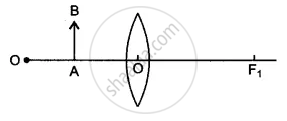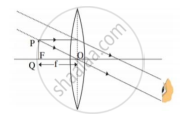Advertisements
Advertisements
Question
Find the nature, position and magnification of the images formed by a convex lens of focal length 0.20 m if the object is placed at a distance of:
0.25 m
Solution
u = -25 cm
f = 20 cm
⇒`1/f=1/v-1/u`
⇒`1/20=1/v-1/-25`
⇒`1/v=1/200-1/25`
⇒`1/v=(5-4)/100`
⇒`1/v=1/100`
⇒`v=100` cm
The image will be formed at a distance of 100 cm behind the mirrror.Magnification,
⇒`m=v/u`
⇒`m=100/-25`
`m=-4`
Magnification is negative, which means the image is real and inverted.
APPEARS IN
RELATED QUESTIONS
A beam of light travelling in air is incident of water. Draw a ray-diagram indicating the change in its path in water.
If the object is moved to a point only 3 cm away from the lens, what is the new position, height and nature of the image?
A student did an experiment with a convex lens. He put an object at different distances 25 cm, 30 cm, 40 cm, 60 cm and 120 cm from the lens. In each case he measured the distance of the image from the lens. His results were 100 cm, 24 cm, 60 cm, 30 cm and 40 cm, respectively. Unfortunately his results are written in wrong order.
What is the focal length of this lens?
What would be the diameter of the image of the flower on the film?
A convex lens forms an image of an object equal to the size of the object. Draw a diagram to illustrate it.
In the following cases, where must an object be placed in front of a convex lens so that the image formed is upright and enlarged?
A convex lens has a divergent action and a concave lens has a convergent action.
Diagram shows an object AB placed on the principal axis B of a convex lens placed in air. F1 and F2 are the two foci of the lens.

(i) Copy the diagram:
Draw a ray of light starting from B and passing through O. Show the same ray after refraction by the lens. Draw another ray from B which passes through F2 after refraction by the lens. Locate the final image
(ii) Is the image real or virtual?
 : Object near the lens : : ______ :
: Object near the lens : : ______ : 
Which of the following statements is true?
